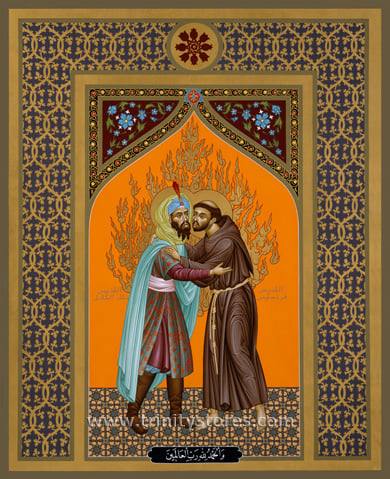
Many churches have recently celebrated the Feast of St Francis of Assisi (around the 4th October). Born in the 12thcentury, we probably know he is the Catholic Church’s patron saint of animals (and the environment). In fact, St Francis Sunday is a popular day in many churches for pets to be blessed. But beyond the cute, fluffy animals, there is also an edgier side to this fascinating saint – for example, his complex (and often untold) relationship with Islam.
In 1219, St. Francis and Brother Illuminato accompanied the armies of western Europe to Damietta, Egypt, during the Fifth Crusade. His desire was to speak peacefully with Muslim people about Christianity, even if it mean dying as a martyr. He tried to stop the Crusaders from attacking the Muslims at the Battle of Damietta, but failed. After the defeat of the western armies, he crossed the battle line with Brother Illuminato, was arrested and beaten by Arab soldiers, and eventually was taken to the sultan, Malek al-Kamil.
Al-Kamil was known as a kind, generous, and fair ruler. He was nephew to the great Salah al-Din. At Damietta alone he offered peace to the Crusaders five times, and, according to western accounts, treated defeated Crusaders humanely. His goal was to establish a peaceful coexistence with Christians.
After an initial attempt by Francis and the sultan to convert each other, both quickly realised that the other already knew and loved God. Francis and Illuminato remained with al-Kamil and his Sufi teacher Fakhr ad-din al-Farisi for as many as twenty days, discussing prayer and the mystical life. When Francis left, al-Kamil gave him an ivory trumpet, which is still preserved in the crypt of the Basilica of San Francesco in Assisi.
This encounter, which occurred between 1st and 26th September, is a paradigm for interfaith dialogue in our time. Despite differences in religion, people of prayer can find common ground in their experiences of God. Dialogue demands that we truly listen to the other; but, before we can listen, we must see the other as a precious human being, loved by God. There is no other path to peace in this bloody 21st century. It is fitting that this year we celebrate Inter-Faith Prayers for World Peace at Aldersgate on the Sunday following St Francis’ Feast Day.
The flames behind Francis and the sultan, in the above icon, have a dual symbolism. In Islamic art, holy persons are shown with balls of flame behind their heads. The second purpose of these flames is to disarm a later medieval legend in which Francis challenged the Sufis to step into a raging fire to prove whose faith was correct. In this icon, the flames represent love. The text at the bottom is from the beginning of the Koran: “Praise to God, Lord of the worlds!”

One response to “Beyond the cute animals: the edgier side of St Francis”